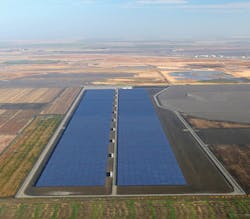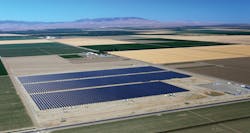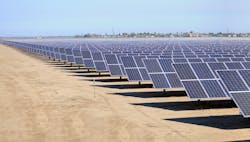PG&E Powers California with Clean Energy
Electric utilities nationwide are searching for ways to provide more clean, renewable electricity to their customers. By building utility-scale solar-generation facilities in their service areas, utilities can interconnect these systems to the grid, thereby harnessing the power of the sun.
For example, consider Pacific Gas and Electric Co. (PG&E). More than half of the electricity it delivers to its customers comes from sources that are renewable, free of greenhouse-gas emissions or both. As part of its clean energy strategy, the utility is now generating 150 MW of clean solar energy, which can power 45,000 homes in its northern and central California service territories. The utility won approval of the new Utility-Owned Photovoltaic Generation program from the California Public Utilities Commission in April 2010 and recently completed the last three of the nine new solar stations.
Supporting Customer-Owned Projects
PG&E serves as an administrator of the California Solar Initiative. This program offers homeowners and business owners financial incentives for installing qualifying solar photovoltaic systems. So far, the utility has helped nearly 90,000 customers interconnect their new solar systems — more than any other utility in the United States.
To qualify for the program, participants currently must be receiving retail electric service, be located within the utility’s service territory and must use equipment approved by the California Energy Commission. In addition, the utility, along with a diverse group of consumer groups and other organizations, proposed a “Green Option” before the California Public Utilities Commission. This option would give customers the opportunity to support 100% renewable energy from new small and mid-sized solar projects located in PG&E’s service area.
Constructing the Solar Stations
PG&E’s Utility-Owned Photovoltaic Generation program includes projects between 10 MW and 20 MW, all of which are located in California’s Fresno and Kings counties near the utility’s substations. This was done to reduce costs associated with interconnecting the new stations to the grid and to locate the new solar generation resources near the customers. Also, because of their smaller size, the projects were able to be developed faster and with fewer delays than larger installations.
To construct its new solar stations, PG&E partnered with EPC contractors Cupertino Electric Inc., Elecnor, Q-Cell and Solon, who, along with their subcontractors, engineered, procured and constructed (EPC) the nine solar stations over a three-year period.
Electrical contracting firms Cupertino Electric and Solon built the first three of the nine ground-mount photovoltaic solar stations in April 2011. These stations include the 15-MW Five Points solar station, 20-MW Stroud solar station and 15-MW Westside solar station. In 2012, Cupertino Electric Inc., along with Q-Cell, completed three more new solar stations: the 20-MW Cantua solar station, 10-MW Giffen solar station and the 20-MW Huron solar station. The last three of the nine solar stations — the 20-MW Gates solar station, 20-MW Guernsey solar station and the 10-MW West Gates solar station — were constructed by Cupertino Electric and Elecnor, and they became operational mid-summer 2013. Together, these nine solar stations consist of more than 700,000 photovoltaic solar modules, more than 200 dc-to-ac inverters and more than 150 transformers.
Throughout the projects, the EPC contractors served as the turnkey contractors. Along with their subcontractors, they were responsible for the installation of all station components, including the racking system, solar modules, inverters and transformers.
Before the EPC contractors began work on the site, PG&E contracted with civil contractors to grade the site and install a security fence around it. Next, the EPC contractors and their subcontractors installed access roads, drove steel posts in the ground for the racking system, dug the underground trenches, laid the underground cable and poured the various concrete pads. Their workers also installed the racking and the individual solar modules. Electricians then pulled all the wiring for the new solar stations, made up all terminations and performed testing. The EPC contractors also set the 12-kV switchgear on its pad and installed the new supervisory control and data acquisition (SCADA) equipment within the station communications building.
The new solar stations were commissioned and performance tested to verify they met all performance guarantees and were ready for commercial operation. Then a request was submitted to the California ISO (CAL-ISO) for approval for the new solar stations to enter commercial operation.
Facing Challenges in the Field
While constructing the solar stations, the workforce faced many challenges. With more than 100 tradespeople on site every day, good communication and coordination were vital to personnel safety and the success of the projects. Cupertino Electric would map out their daily work plans to ensure they had the required equipment, labor and materials they needed. At the beginning of each day, they would then communicate their plan to their staff. They also had to make sure if the work assignments changed during the day, they promptly and effectively communicated this change to their teams.
Adding to the challenges were varying weather conditions ranging from dense fog, high winds, rain and resulting mud, to soaring summertime temperatures. Keeping everyone safe and the project on schedule required very close coordination with everyone involved.
Transporting equipment also proved challenging because of the remoteness of the site locations. A typical solar station can span more than 120 acres and thus ensuring the equipment got to the right location at the right time proved to be a logistical challenge. Cupertino Electric also worked hard to minimize the amount of lost time the workers spent walking or driving from one part of the site to the next as work progressed.
Each site also was unique because of the shape of the property, soil conditions, natural slope of the property, endangered species and various ground cover, each of which required an engineering response to address. During construction, PG&E’s contractors worked to minimize the amount of dust and air emissions generated during the construction process to satisfy adjacent farming interests and local air district requirements.
As the time approached to back feed energy for the first time, the contractor worked closely with PG&E to ensure the required communications and metering equipment were installed, certified and ready for the new station to interconnect to the grid in time for the start of commissioning activities. This work also included all required communications system (SCADA) upgrades to the PG&E operations control center for monitoring and control of the new stations. Concurrently, fillings were made with CAL-ISO to gain approval to tie into the grid for the first time. This required following all CAL-ISO and PG&E procedures to ensure submittals were submitted in timely manner and the content was correct for approval to tie onto the grid.
Relying on Solar Technicians
Once the construction teams were done and the site was declared commercial, operations and maintenance responsibilities were turned over to a select team of solar technicians. This team consists of four IBEW journeymen electricians who are responsible for preventative and corrective maintenance on all solar station equipment.
The technicians are headquartered about 20 minutes south of Fresno in Caruthers, California. They arrive at their headquarters, and in coordination with PG&E’s Fresno Operations Center, ascertain the status of the various pieces of solar station equipment.
The technicians get their individual work assignments, go over their daily safety tailboard and then dispatch to the various solar stations for their assigned work. With the advent of the new technology brought on by the Utility-Owned Photovoltaic Generation program, the solar technicians work daily with electrical voltages ranging from 24 Vdc to 1,000 Vdc
and up to 12,470 Vac. With hundreds of pieces of equipment all looking alike, driving distances averaging 30 miles between solar stations, and challenging ambient weather working conditions, the job duties are diverse and require constant vigilance.
Installing the new solar stations allows PG&E to be able to offer its customers clean, renewable solar energy. Through this multi-year program, Californians can now use this energy from the sun to help power their homes and businesses.
Companies mentioned:
Cupertino Electric Inc. | www.cei.com
Elecnor | www.elecnor.us
IBEW | www.ibew.org
Pacific Gas & Electric | www.pge.com
Q-Cell | www.q-cells.us
Solon | www.solon.com
About the Author
Amy Fischbach
Electric Utilities Operations
Amy Fischbach is the Field Editor for T&D World magazine and manages the Electric Utility Operations section. She is the host of the Line Life Podcast, which celebrates the grit, courage and inspirational teamwork of the line trade. She also works on the annual Lineworker Supplement and the Vegetation Management Supplement as well as the Lineman Life and Lineman's Rodeo News enewsletters. Amy also covers events such as the Trees & Utilities conference and the International Lineman's Rodeo. She is the past president of the ASBPE Educational Foundation and ASBPE and earned her bachelor's and master's degrees in journalism from Kansas State University. She can be reached at [email protected].



